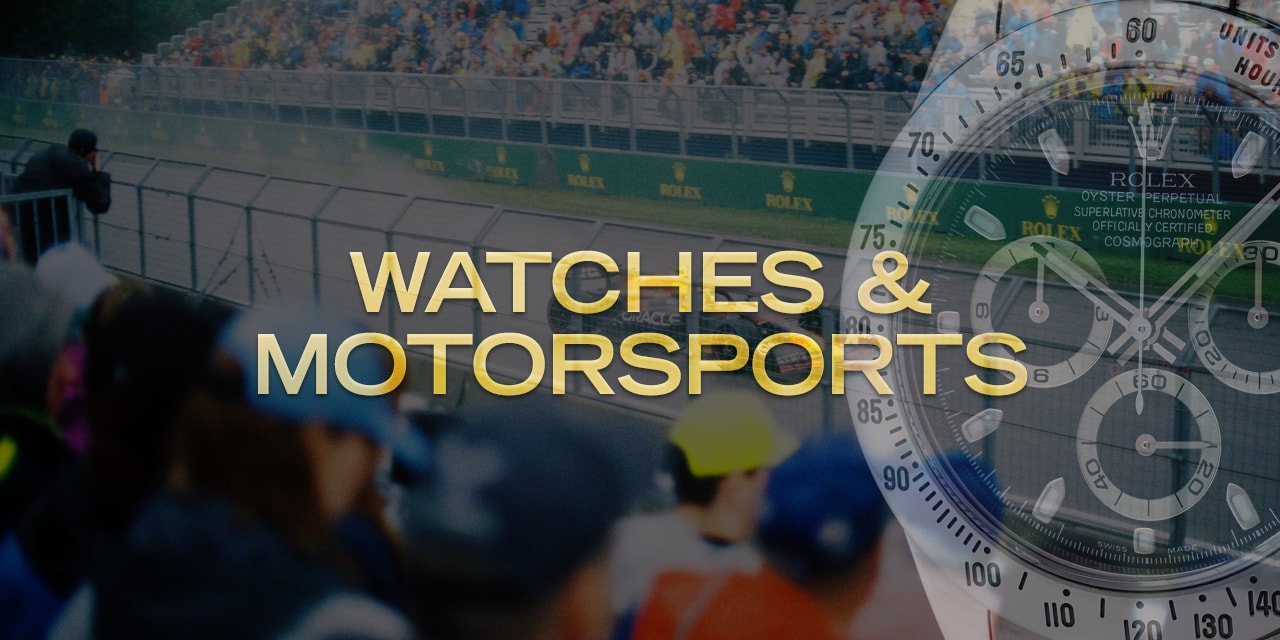Watches and Motorsport
It’s a pretty obvious statement but, without accurate timekeeping there can be no racing. And of all the various forms competing can take, it is surely in motorsport where the need for split-second accuracy is most called for.
The bond between the meticulously fastidious world of watchmaking and the high octane thrills, glamor and danger of motor racing is a surprisingly strong and enduring one. But it perhaps shouldn’t surprise us that much. There are plenty of similarities between the two disciplines.
Both are entirely dependent on some of the most advanced engineering practices on the planet, albeit at vastly different scales. Each is dominated by an overwhelming demand for precision, with tolerances measured in fractions of a millimeter. They have both been responsible for pioneering innovations in techniques, materials and design. And at their heart, each one is fundamentally all about the importance of timing.
Watches in Motorsport: History
For many of the most significant advances in sports timing, we have to turn to Heuer. Their ground-breaking work saw them first invent the oscillating pinion in 1887, a system for connecting a chronograph module to a watch movement which was cheaper and simpler than the horizontal clutch arrangement of the time. It was, in fact, so well designed that it is still used in calibers today.
After unveiling their first chrono pocket watch just five years later, Heuer would go on to become one of the preeminent names in motor racing timekeeping of the 20th century.
In 1911, they brought out the Time of Trip, the first ever dashboard timer for both cars and airplanes. It had a small sub dial supplementing the main display to keep track of a journey’s duration. The success of that device saw a procession of others, with the Master Time, the Monaco and the Autavia all following on.
They introduced the hugely impressive Mikrograph in 1916, the first stopwatch capable of timing down to 1/100 of a second, then the Semikrograph, accurate to 1/50th of a second and also benefitting from a split-second function.
But Heuer was also responsible for a number of racing’s most iconic wristwatches. The 1960s gave us the Carrera, as well as two other legendary pieces which borrowed their names from those earlier timers; the Monaco and the Autavia. And by the end of the decade, they had developed the Calibre 11 in conjunction with the Chronomatic Group consortium, one of the winners of the three-horse race to develop the first automatically-winding chronograph movement.
Watches in Motorsport: The Great Names
Of course, Heuer didn’t have the field entirely to themselves. Other brands have produced models for or inspired by motor racing which now stand as some of the most recognizable watches ever made.
Arguably the greatest among them remains Rolex’s Daytona. Named after the Floridian speedway circuit, the Daytona began life in 1963 as an underwhelming, manually-wound piece, evolving through its automatic, El Primero-powered years before going all in-house in 2000. Now into its fourth generation, the Daytona can be had in steel, all three flavors of gold, yellow Rolesor and even platinum, and it still ranks as possibly the most important sports watch of all time.
Chasing hard for that title is Omega’s wonderful Speedmaster. Although now far better known for its interstellar ambitions, the Speedy started out as a racer’s watch and was the first to move its tachymeter scale to the bezel rather than having it on the dial. Over the years there have been too many variations on the Speedmaster’s theme to name, but the two-counter ‘Racing’ and ‘Super Racing’ collections carry on the watch’s proud tradition.
To underline just how close is the association between many leading watchmakers and a variety of luxury car marques, the world of horology is awash with collaborations between the two.
Breitling teamed up with Bentley in 2002 when they were called on to develop an onboard clock for the Continental GT. Since then, the brand has produced a litany of ‘Breitling for Bentley’ models, nearly all of them featuring bezels with the carmaker’s distinctive honeycomb grille pattern to create a cohesive collection.
Taking things up several notches, avant-garde manufacture Richard Mille is the brand perhaps most synonymous with motor racing at the highest levels today. They have been partnered with Aston Martin since 2016 as well as now sponsoring two of the major Formula 1 teams; McLaren and Ferrari. For the former they produced, among others, the world’s lightest split-seconds chronograph with tourbillon watch in 2017, the ‘RM 50-03 Tourbillon Split Seconds Chronograph Ultralight McLaren F1’ weighing in at just 40g. And more recently, their relationship with Ferrari resulted in the ‘RM UP-01 Ferrari’, currently the thinnest watch in the world, measuring a mere 1.75mm in height, almost exactly 1mm thicker than a credit card.
Mille actually have Formula 1 pretty well sewn up. Not content with backing the teams, they also have official partnership deals with several of the drivers as well, regardless of who they drive for. Mick Schumacher, Charles Leclerc, Fernando Alonso, Kiki Raikönnen and Romain Grosjean are all under the RM banner.
Ferrari have had a number of other associations with watch brands over the years. Panerai enjoyed a five-year spell with the label which made sense to a lot of people, both drawing on the passion and heritage of their Italian roots.
And controversial practitioners Hublot created some incredible pieces in association with Ferrari in recent years. There have been more than 70 typically outlandish examples, mostly in the flagship Big Bang series, including those cast from their proprietary Magic Gold, where 24k gold is injected into a boron carbide material to give a compound with the look of the precious metal and the strength of a technical ceramic. And in 2013, they unveiled the insane MP-05 LaFerrari superwatch, a model featuring 11 series-coupled barrels and a 50-day power reserve, wrapped up in a design replicating the look through the cover of a LaFerrari engine bay. No longer in production, you can snap one up on the preowned market for around $200,000.
Watch brands and carmakers have long had an extremely fertile and fruitful relationship. Two arenas of exacting discipline, horology has been pushed to ever greater heights by the association.
Nowadays there seems to be no slowing down in affiliation, and we are all treated to more and more impressive watches as a result.
Featured Photo: Pexels (cc) Archive 1, 2, and BeckerTime’s Archive.







